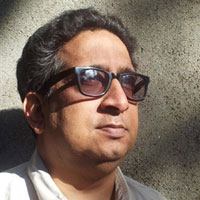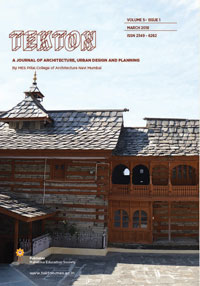Mustansir Dalvi
Tekton
Volume 5, Issue 1, March 2018
pp. 56 – 73
 Mustansir Dalvi is Professor of Architecture at Sir JJ College of Architecture. In his doctoral research completed at the IIT-Bombay (IDC), he has charted a semiotic of Bombay’s Art Deco Architecture. He has lectured, read and published several papers on architectural history and heritage, urban transformation and architectural semiotics. He has regularly contributed to architectural and cultural magazines besides writing columns for newspapers, popular magazines and online news portals. He is the editor of 20th Century Compulsions (Marg, 2016) – early writings about Indian modernist architecture and the author of The Past as Present: pedagogical practices in architecture at the Bombay School of Art (Sir JJ/UDRI, 2016).
Mustansir Dalvi is Professor of Architecture at Sir JJ College of Architecture. In his doctoral research completed at the IIT-Bombay (IDC), he has charted a semiotic of Bombay’s Art Deco Architecture. He has lectured, read and published several papers on architectural history and heritage, urban transformation and architectural semiotics. He has regularly contributed to architectural and cultural magazines besides writing columns for newspapers, popular magazines and online news portals. He is the editor of 20th Century Compulsions (Marg, 2016) – early writings about Indian modernist architecture and the author of The Past as Present: pedagogical practices in architecture at the Bombay School of Art (Sir JJ/UDRI, 2016).
mustansirdalvi@gmail.com
ABSTRACT
This paper traces the development of a modern urban sensibility in the practitioners of architecture in Bombay in the decades before the Nation State. Largely home-grown, they embraced a form of international Modernism. The architecture of the time was prolific but was in contrast to imperialist monumentality. The writings of the 1930s and 1940s that follow these developments are often polemical, pragmatic and even contradictory; but unabashed and outspoken. Both architects and laypersons vigorously debated and argued in public lectures and meetings what Claude Batley would call ‘This New Architecture’. Journals and books would disseminate new ways of living and building that were influential in Bombay and all over India. Cement companies would be at the forefront, disseminating products by publicising notable examples of architecture built every year. It is this ‘new architecture’ that has retrospectively been labelled ‘Art Deco’. This non-monumental, functionalist architecture for contemporary needs defined the urban image of the emerging metropolis. This paper charts these transitions through the
voices of the protagonists themselves.
KEY WORDS
Bombay, Art-Deco, Modernity, 20th Century, Architectural Practices, Style Moderne, Indian Modernism Before Independence.


